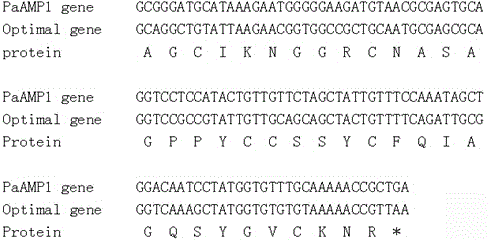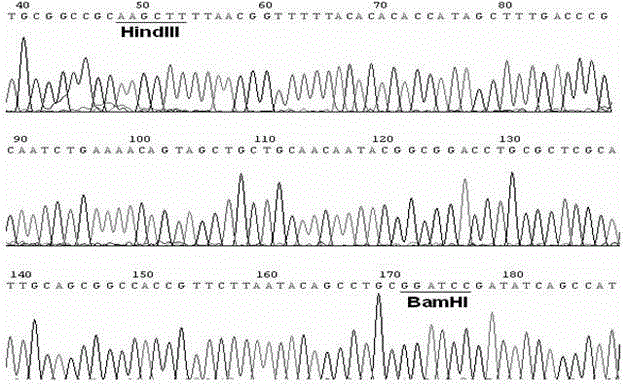Preparation method of antalgic active polypeptide
A technology of active peptides and plant antimicrobial peptides, applied in the field of genetic engineering, can solve the problems of low content and limited quantity of PaAMP, and achieve the effect of abundant resources, meeting drug research and development and clinical needs, and efficient soluble expression
- Summary
- Abstract
- Description
- Claims
- Application Information
AI Technical Summary
Problems solved by technology
Method used
Image
Examples
Embodiment 1
[0024] Example 1: Synthesis and identification of pokeweed antimicrobial peptide PaAMP1 gene
[0025] The codons of the PaAMP1 gene (GenBank: AF048745) were optimized according to codon usage frequency in E. coli (see figure 1 ), the codon-optimized PaAMP1 gene sequence is SEQ ID NO.1, and the encoded protein sequence is SEQ ID NO.2.
[0026] SEQ ID NO.1:
[0027] gcaggctgta ttaagaacgg tggccgctgc aatgcgagcg caggtccgcc gtattgttgc
[0028] agcagctact gttttcagat tgcgggtcaa agctatggtg tgtgtaaaaa ccgttaa
[0029] SEQ ID NO.2:
[0030] Ala Gly Cys Ile Lys Asn Gly Gly Arg Cys Asn Ala Ser Ala Gly Pro
[0031] Pro Tyr Cys Cys Ser Ser Ser Tyr Cys Phe Gln Ile Ala Gly Gln Ser Tyr
[0032] Gly Val Cys Lys Asn Arg
[0033] The PaAMP1 gene (synthesized by Shanghai Jierui Biotechnology Co., Ltd.) was synthesized by chemical method, and the Bam HI / Hind After the double enzyme digestion of III, it was connected into the prokaryotic expression vector pET-32a (purchased from Novagen...
Embodiment 2
[0034] Example 2: Expression and separation and purification of recombinant PaAMP1
[0035] The verified correct recombinant plasmid pET-32a-PaAMP1 was introduced into the competent cells of Escherichia coli Origami (DE3) strain (purchased from Novagen) by heat shock method to obtain the genetically engineered bacterium Origami-PaAMP1.
[0036] Inoculate the Origami-PaAMP1 strain in LB medium (containing ampicillin 100 μg / mL), culture with shaking at 37°C until OD 600The value is about 0.8. Cool the cultured Origami-PaAMP1 cells to 28°C, add IPTG with a final concentration of 1mmol / L, and culture with shaking at 28°C for 12 hours. Cells were collected by centrifugation, frozen and thawed five times at 37°C / -20°C, and ultrasonically disrupted at 200w. After high-speed centrifugation, soluble recombinant PaAMP1 was isolated from the supernatant using nickel ion resin. The purified recombinant PaAMP1 was dialyzed to remove impurities such as imidazole, and then the recombinan...
Embodiment 3
[0038] Example 3: Analysis of the analgesic activity of recombinant PaAMP1
[0039] The experimental group was injected with different doses of the recombinant antimicrobial peptide PaAMP1 solution obtained in Example 2 (2.0mg / kg, 5.0mg / kg), the negative control group was injected with normal saline (0.9% NaCl), and the positive control group was injected with recombinant conus Toxin ω-MVIIA. Each group was injected with 20 male mice, each with a body weight of 20 ± 0.2 g. 45 minutes after administration, each mouse was injected with 0.2 mL of 0.6% glacial acetic acid to stimulate writhing behavior, and the writhing movements of each mouse within 20 minutes were counted, and then the experimental data were statistically analyzed.
[0040] The results showed that when the dose of PaAMP1 was 2.0 mg / kg, the average number of writhing times in mice was 20.95 times, 21.10 times in the positive control group, and 37.20 times in the negative control group; The frequency was 1.60 ...
PUM
| Property | Measurement | Unit |
|---|---|---|
| molecular weight | aaaaa | aaaaa |
Abstract
Description
Claims
Application Information
 Login to View More
Login to View More - R&D
- Intellectual Property
- Life Sciences
- Materials
- Tech Scout
- Unparalleled Data Quality
- Higher Quality Content
- 60% Fewer Hallucinations
Browse by: Latest US Patents, China's latest patents, Technical Efficacy Thesaurus, Application Domain, Technology Topic, Popular Technical Reports.
© 2025 PatSnap. All rights reserved.Legal|Privacy policy|Modern Slavery Act Transparency Statement|Sitemap|About US| Contact US: help@patsnap.com



